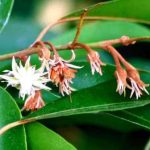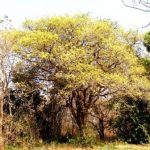TREE LIFE
September 2004
MASHONALAND CALENDAR
Saturday 4th September. Botanic Garden Walk. We hope that in Tom’s absence Meg will step in to lead the walk. Meet in the car park at 10.45 for 11am.
Sunday 19th September
It’s a long time since we went to the Chinamora/Masembura areas east of Harare. One of the interesting spots is Chikupu Caves. There is a stream which trickles along most of the year so the vegetation there should be a little greener than in the surrounding countryside. The four caves are said by Peter Garlake in his book Painted Caves to contain probably the greatest number of paintings on any site in Zimbabwe, most of them in excellent condition.
Saturday 25th September. Mark’s walk will be on Mrs Doris Kileff’s 30 acres Bunkers Hill close to the airport..
Tuesday 5th October. Botanic Garden Walk.
Note that summer has returned so the walks revert to Tuesday evenings.
MATABELELAND CALENDAR
Sunday 19th September. Meet at 7.30 at the home of Val Deas.
INDIGENOUS TREE FLOWERING
Meg Coates Palgrave’s article in Tree Life 292 on indigenous tree flowering interested me with regard to her comments on the pollination of some trees mentioned. As a beekeeper, I have made observations on a few of the trees described.
Albizia versicolor – Before I was chased away from my apiary site near Banket, there was a magnificent specimen close by and during my first season there it flowered profusely and was a sight to behold. My bees were also impressed, and a very heavy fruit set ensued. Interestingly, however, the following season produced very few flowers indeed and I thought that possibly this particular tree had used up considerable energy reserves the previous year which had restricted the flowering in the next.
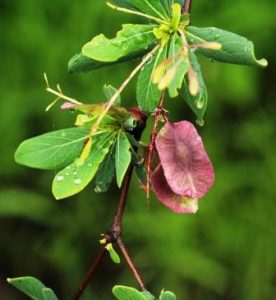
Terminalia stuhlmannii. Photo: Bart Wursten. Source: Flora of Zimbabwe
Kigelia africana – Meg says this tree is probably bat pollinated. As stated by her, it produces copious nectar. Honey bees find the flowers very attractive, and one can assume they pollinate the flowers in the process of collecting its nectar.
Terminalia spp. – Several species of this tree (if not all) are attractive to honey bees but it is generally accepted that the honey there from is unmarketable due to its unpleasant flavour. Having said that, one season I left behind a few bee hives at Charara Estate, Kariba, after completing a pollination contract. This coincided with heavy flowering of Terminalia stuhlmannii. The resultant honey had a very distinctive flavour, very much reminiscent of the scent of the flowers, and not unpleasant to the taste at all.
-Peter Taylor
PLEASANT VALLEY: SUNDAY, JULY 18TH, 2004
By kind permission of Kevin Fallon, our outing was to Pleasant Valley Farm, near Arcturus. Maybe it was because of the desire to get out of town and enjoy the bush or maybe it was the promise of potjiekos for lunch, but for whatever the reason our attendance was particularly good at just over 30.
This was also the second outing in which we had split the members into two groups, one learner’s group following Rob Burrett and a more advanced group led by me. This write-up obviously is only concerned with the trees my group saw, but by all accounts, this splitting has turned out to be an excellent idea it is not easy to cope with all levels of knowledge at once. It also provides good variety from me leading all the outings.
We set off down the slope from the farmhouse into woodland near the river. The GPS told us that we were a bit lower than usual at 1300 m (about 4300 ft for the non-metricated).
One of the trees which is local in the Harare area is Rauvolfia caffra, the Quinine tree. Around here it is a riverine species, although I must say that it does very well out of habitat in our garden in Alexandra Park. In the Eastern Highlands with their higher rainfall, the species is less choosy and may occur more widely but in practice it is often a species of forest edges.
The leaves occur in whorls and, as with many Apocynaceae, milky latex is produced from the stem. The inflorescence consists of greenish flowers in a flat-topped, usually terminal, arrangement. Fruits are more or less spherical.
Another slightly local riverine species was Ekebergia capensis, (the Dogplum) of which there were numerous specimens. This is from the Mahogany family, Meliaceae; it has medium-sized, dark green, pinnate leaves with a terminal leaflet (i.e. they are imparipinnate). Flowers in this genus are rather small and inconspicuous.
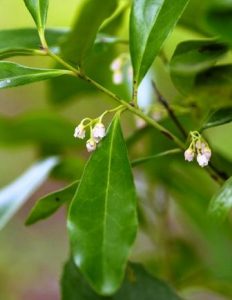
Euclea racemosa subsp. schimperi. Photo: Bart Wursten. Source: Flora of Zimbabwe
Also riverine was Mimusops zeyheri (Common red milkwood). This can be a puzzling species to name when there are no flowers or fruits, with its spiral glossy leaves and milky latex; for example it can look like some strange species of fig. It is a riverine species but also occurs in rocky habitats as well. Euclea racemosa subsp. schimperi (Bush guarri) also occupies the same combination of riverine/rocky habitats as well and we saw plenty of this. So too does Englerophytum magalismontanum (the Stem fruit), also found in the shade of the riverine forest.
In the riverine fringe, were the usual exotics and weedy native species. One quite attractive large shrub is Vernonia myriantha (Poison tree vernonia) which has large flat-topped inflorescences of whitish-purple flowers which can be quite striking. Guava plants (Psidium guajava) were also seen as well as escaped Cedrela, namely Toona ciliata. In the understorey were plants of Senna septemtrionalis, a yellow flowered senna, introduced from America.
A very attractive garden plant which escapes around Harare is Passiflora subpeltata. It is a climber and has white flowers and small green fruits. There was a lot of it here in the shadier riverine.
A very striking specimen of was also found, this has long flower spikes of whitish flowers. The plant is a scrambler rather than a tree but it may attain considerable heights and look quite tree-like when supported by other woody plants.
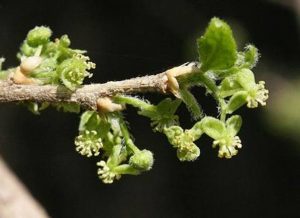
Erythrococca trichogyne. Photo: Bart Wursten. Source: Flora of Zimbabwe
Erythrococca trichogyne, the Twin red-berry often doesn’t look very distinctive, but when in fruit it shows the red arils of its seeds. It is a Euphorbiaceae, which occurs occasionally in the Harare area.
Lunch was a sumptuous affair and we are very grateful to Kevin and Iona for their generosity to the Society. After such a good lunch, energy was rather lacking but a number of people joined me in walking up the slope behind the house into some miombo woodland. There we saw a different selection of species many typical of that habitat.
All in all it was a most enjoyable day. I’d like to thank Rob Burrett for leading the learners group and Kevin and Iona Fallon for their hospitality.
-Mark Hyde
BOTANIC GARDEN WALK: 3 JULY 2004
We were very fortunate, in the absence of Tom Muller, to have Meg Coates Palgrave to lead us in the Gardens and talk about miombo woodland.
Miombo woodland is an East African colloquial term. It is defined as woodland which is dominated by species from one of the three genera: Brachystegia, Isoberlinia or Julbernardia.
It occurs in Africa south of the Equator to just south of Zimbabwe and consists of deciduous woodland, the canopy of which is completely closed or almost so.
In Zimbabwe we have no Isoberlinia; but we do have several Brachystegia spp., the best known of which is probably the msasa, and one Julbernardia. Most (maybe all?) have the typical reddish-brown flush when their new leaves appear in spring and Meg explained that this was effectively a sun screen, namely a means of protecting the young leaf from sun damage. After 24 days, the leaves turn green.
Zimbabwe lies at the southern end of miombo woodland and is relatively poor in species. Zambia is the centre of diversity for Brachystegia, where it is wetter and more scope for species to evolve. It is no accident that our richest areas tend to be in the N and E of the country, that is up towards the Zambian border.
The soils in miombo woodland tend to be poor; local areas of species richness do however occur on granite kopjes, termite mounds and riverine fringes. Most of the trees have a thick bark to protect them from fire.
Brachystegia glaucescens (Mountain acacia)
This was the first species we examined; it is invariably a species of rocky places. The bark is relatively thin (it doesn’t need to worry about fire) and the pods usually have a purplish tinge. As with all the miombo species, the leaves are paripinnate.
Brachystegia spiciformis (Msasa)
A specimen of this species which was fruiting at eye-level was examined. Meg showed the vestigial stipels at the base of each leaflet; these do not occur in Julbernardia and provide a character to separate the two. The terminal pair of leaflets are the largest and the weight of these means the leaves tend to wave in the breeze. The flowers occur as soon as the leaves grow green, typically in September, and are pleasantly fragrant. The pods are glabrous and occur within and on top of the canopy.
Julbernardia globiflora (Mnondo)
This has no stipels. The leaves are definitely hairy, especially on the margins and rachis. The largest leaflets are in the middle, not the end and therefore the leaves are not in constant motion.
The pods are furry and are borne above the canopy. It flowers much later in the year (January).
Brachystegia boehmii (Mufuti)
This is the fourth common component of miombo woodland in Zimbabwe. The leaves have many pairs of leaflets and are larger than the other three species. This occupies slightly lower altitude, drier woodland than B. spiciformis but is very common throughout much of Zimbabwe.
A question was raised about the existence of hybrids and particularly Brachystegia spiciformis glaucescens. It seems that further work is needed to establish whether this really occurs and what form(s) it takes.
Having looked at the principal components which define miombo woodland, we looked at some of the trees which commonly occur there. These included: Albizia antunesiana, Bolusanthus speciosus, Bridelia cathartica, Carissa edulis, Combretum molle, Flacourtia indica, Monotes glaber, Peltophorum africanum, Pittosporum viridiflorum, Pterocarpus rotundifolius, Terminalia sericea and Vangueriopsis lanciflora.
But the piece de resistance was definitely a fruiting specimen of Pappea capensis (the Indaba tree). Although a common tree, Meg mentioned that she had rarely seen them in fruit and I would support that. It has short pendulous inflorescences bearing more or less spherical fruit from which bulge a fleshy red aril. The effect is very striking indeed and made a very satisfactory end to a long and interesting walk. Thanks, Meg, for your time and expertise. Both are very much appreciated.
-Mark Hyde
THE PETHERAM FILES Compiled by Lyn Mullin
Richard Walter Petheram, known to most of his associates as Dick (and, for reasons unknown, to some of his close friends as Peter), had a long and distinguished career in the Southern Rhodesian Civil Service, finally retiring in the late 1960s as Deputy Secretary for Mines and Lands. In his administrative capacity he had close association with the Forestry Commission, and perhaps it was this that helped develop his abiding interest in, and love of, trees. He was a prominent member of the Tree Society for many years, serving in various capacities on the Committee. He was one of the leading advocates for the preservation of the Mukuvisi Woodlands, and the development of this beautiful area into what it has become today.
As one would expect from a senior Civil Servant in the earlier administration of this country, Dick Petheram had an extremely orderly approach to whatever he was doing, a trait that extended to the private files he maintained on trees and other subjects that interested him. After his death his files on trees and other related matters were given to the Tree Society for use in whatever way seemed appropriate, and, as a rather belated tribute to Dick, extracts from these files will appear in TREE LIFE from time to time. These extracts will appear in Dick’s own words, edited only where absolutely necessary, particularly to update botanical and place names. Comments have been added where they have seemed appropriate, and appear in square brackets in a smaller font as [Comment 2002:].
TREES AND A LITTLE HISTORY
[Comment 2002 This file was undated, and appears to have been the text of an address, perhaps to a school, some time in 1976 or earlier. The text of this address was published in The Rhodesia Science News in 1976 (? Volume 10) but there is no record in the files of which Number. All place names in the original text have been changed to reflect the post-Independence era, except in one or two cases where the old names are more appropriate. A section on palaeobotanic that was included under this heading has been transferred to File 3, which deals at greater length with this subject.]Introduction
At a time when the unwritten code of our society was spare the rod and spoil the child, we had at school a teacher to whom the preservation of trees had nothing whatever to do with beauty or conservation. To him they grew for one purpose only, and to those who were inattentive in class he handed over his pocket knife, and wordlessly pointed to the trees outside the window. When the required switch had been cut, he tested it for tone and texture, then proceeded to administer justice.
Prevailing attitudes towards corporal punishment at school seem to change from time to time and I wouldn’t want to become involved in a debate on the subject but there was a time at boys schools when trees became deeply impressed upon one’s system during childhood, and looking back, at least a tiny part of the history of the school system, as we knew it, was tied up most feelingly with trees. There is no implied threat in this little tale I simply wish to make the point that although we had no lessons in botany as such, something about trees was absorbed into our systems.
To everyone, a tree with particular associations embraces within its branches a little bit of history present or past, sad or glad, family history, community history, or national history. There are many such trees in Zimbabwe, with associations of the most diverse nature; trees connected by the lengthening thread of years to the trials, tribulations, and triumphs of early white settlers, trees subsequently planted to commemorate those eventful times, trees that witnessed the struggles and accomplishments of earlier adventurers, trees feared or revered by a relatively primitive people because of size, or shape, or rarity.
Some trees in the latter category might well place under considerable strain the strict definitions of the two terms historic and historical, but they are, I believe, part of the fabric of our history.
[Comment 2002: the author had a note in the margin that reads Concise Oxford Dictionary historical = belonging to history, not legend; historic = noted in history.]There is, in addition, a wide range of exotic trees of historical significance the mission plantings in Matabeleland prior to the Occupation; the large plantations of people like Swynnerton near Chipinge, and William Harvey Brown outside Harare in the 1890s; the arboretum development at Matopos in the early 1900s; and many other plantings over the years. These latter include, for example, the golden Lawson’s cypress of Major Randolph Nesbitt, VC, at Goromonzi, now some 70 years old, and the Schizolobium parahyba planted as recently as 1951 in what is now Africa Unity Square, Harare, by the last two surviving members of the Pioneer Column, J Crawford and JA Palmer. That Schizolobium, by the way, was planted with the same silver spade that was used by the late King George VI to plant trees at Government House a few years previously.
In passing, I think it might be of interest to know that quite a large quantity of seed of sundry exotics was distributed from the Matopos nursery in 1903/4 to Nyanga, and in 1904, also, to Mutare, Chimanimani, and Victoria Falls. The seed was sent up in some cases from the Cape, but in many cases it was imported from India, Nepal, and Australia. There might also have been quite an interchange of plants between Matopos and the Bulawayo Park at about that time. Certainly Matopos received a large number of seedlings from the Park, in addition to those raised in its own nursery.
The drawback to so wide a field of investigation is that one inevitably gets snarled up in everything from mysterious old lemon groves in the heart of the bush to the vexed question of whether Mr Andre Holland’s grandfather planted the first jacaranda in Harare.
[Comment 2002: The question of who planted the first jacaranda in Harare was pretty well settled by Major HG Mundy in an article that appeared in The Rhodesia Herald on 17 December 1958. He attributed the first jacaranda to a Mrs JM Orpen, and the date as late 1899 or early 1900. The site of the first planting was in No 13 Montagu Avenue (formerly Cape Avenue), which later became No 23 Montagu Avenue, and subsequently No 23 Josiah Chinamano Avenue. However, it appears from cuttings and notes in another of Dick Petheram’s files, that Mrs JM Orpen became the mother-in-law of Andre Holland’s grandfather, Mr AT Holland, who had brought the jacaranda seedling with him from Durban in South Africa, and presented it to his prospective in-laws.]Indian Connection?
In an article in the 1940s, Swedish missionary Harald von Sicard suggested that in the very early centuries AD there was possibly an Indian period in this part of the world. In casting around for further evidence of this, I was interested to read, in one of Roger Summers works, the theory that Indian prospectors came to Zimbabwe in about the 6th or 7th century to find an alternative source of gold to the then rapidly diminishing ore reserves in Mysore. The theory is based largely on the evidence that ancient Zimbabwean mining methods differed from those in use anywhere else in Africa, but were very close to those used in southern India.
Of more direct relevance to trees, however, was Summers further theory that while initial prospecting at that time took place along the river valleys, where alluvial samples were panned, traced up to their source, and so on, detailed exploration of the gold-bearing areas was guided to a considerable extent by observation of vegetation patterns. We freely acknowledge nowadays, of course, that vegetation can be a useful indicator of all kinds of things. But we have so many additional, modern, scientific aids that we tend to overlook the extent to which trees might well have guided and even controlled, to some degree the steps and activities of mankind so long ago, in spheres other than the obvious ones of food, shelter, and medicine.
This brings us to the often-heard theory that this, that, or the other species of tree was introduced by early explorers and traders, but only in a few cases can one get much in the way of convincing evidence. As early as 1905 Richard Nicklin Hall (1853-1914) included in his writings on ancient ruins the observation that the ancients might have introduced the mahobohobo or muzhanje (Uapaca kirkiana), and grown it around the mines. There are similar claims for other trees.
[Comment 2002: See The Ancient Ruins of Rhodesia by RN Hall and WG Neal, first published in 1904, and reprinted in 1972 in the Books of Rhodesia Gold Series.]Summers suggested with some logic, however, that the noticeable presence of some indigenous fruit trees in the vicinity of ancient workings could be (and I quote) due to the fortuitous introduction by the mining populations. He pointed out that fig trees stand out in many places, not necessarily because they were planted there, but because they survive fires best in protected places such as the depressions that mark ancient workings, and the so-called slave pits of Nyanga.
Portuguese Connection
There seems to be no doubt, however, that the old Mazowe lemons were introduced, and, I suppose, more probably by the Portuguese in this country than by the Arabs or anyone else, notwithstanding their east Asian origin. Lemon groves are closely associated with some of the 16th– and 17th-century Portuguese forts and trading centres in present-day Zimbabwe. Dambarare (or Dandebara), one of their three most important trading center’s, was described by Barreto in 1667 as a noble settlement and good-sized town in the heart of Makaranga, [which] has grown to be the centre of that conquest, with many rich inhabitants. The Dambarare site is within 50 kilometres of present-day Harare. Its ruins are on the farm Doxford, near the Jumbo Mine. The lemons are still there. They are also near an old Portuguese fort on the Angwa River near Mhanguranot so very far from our favourite lemon forest at Ditchwe.
[Comment 2002: The Barreto referred to above was the Jesuit, Father Manuel Barreto. Whether the lemons, or any other fruit trees, were deliberately planted or simply grew from discarded seeds is a matter for speculation and no final answer.]I might add that old issues of The Rhodesia Agricultural Journal show that in the early 1900s the Mazowe lemon stock was commonly being used by our horticulturists for the budding of other varieties of citrus.
Another tree associated with the Portuguese, and sometimes with the Arabs, is Ziziphus mauritiana, known to the Shona people as musau or musawu. Some-times it is known in English as Portuguese apple. The fruit of this tree makes the most potent, gin-like drink called kachaso a real scalp raiser, judging by the couple of gulps my wife and I once had. The Portuguese taught the African people along the Zambezi how to distil it through a gun barrel (WV Brelsford). In recent years the fruit has been exploited commercially, and a rather less explosive version of kachaso was marketed successfully in the high-density urban areas until it became difficult to get the fruit up from the Zambezi valley.
Literature on the Rhamnaceae contained in the known to be indigenous to Africa. It gives as its probable origin the Middle East or the Indian subcontinent.
[Comment 2002: DJ Mabberley (1993), The Plant-Book, has Z. mauritiana as indigenous to India, where it is known as ber.]Rare trees, or rare species, also evoke suppositions of introduction by man. The raphia palm (Raphia farinifera) is one such, but I am informed that its rarity in Zimbabwe stems simply from the fact that Zimbabwe is the southernmost limit of its range on the African continent. The same applies to the picturesque bottle palm (Borassus aethiopum). The tamarind (Tamarindus indica), widely thought to have been introduced into Africa by man, is also acknowledged as indigenous by the authorities. So is Bivinia jalbertii, a Madagascan species isolated in Zimbabwe in the southeast lowveld.
[Comment 2002: B. jalbertii is reported in Flora Zambesiaca Vol 1, Part 1, as occurring in Zimbabwe, Mozambique, Tanzania, Kenya, and Madagascar. In Dale & Greenway (1961), Kenya Trees and Shrubs, it is spelt as B. jaubertii, but Flora Zambesiaca makes it clear that this is incorrect. What is interesting is that Mabberley (1993), The Plant-Book, does not list Bivinia at all, but does list Calantica, and Flora Zambesiaca has Calantica jalbertii as a synonym of Bivinia jalbertii. In the mid 1990s there was a certain amount of concern that B. jalbertii was on the verge of a name change, but nothing seems to have happened so far.]On the other hand, the so-called horseradish tree, of the Mana Pools area, is regarded as having been introduced and also the physic nut tree, Jatropha curcas, which, I understand, is found at Diana’s Vow near Rusape, and on similar kopje sites with ruins on them.
[Comment 2002: According to Mabberley (1993), The Plant-Book, Moringa oleifera comes from northwest India, and Jatropha curcas from tropical America.]To be continued.
MARK HYDE CHAIRMAN


